Basil I › Basil II › Dogs in Ancient Egypt » Origins and History
Articles and Definitions › Contents
- Basil I › Who Was
- Basil II › Who Was
- Dogs in Ancient Egypt › Origins
Ancient civilizations › Historical places, and their characters
Basil I › Who Was
Definition and Origins
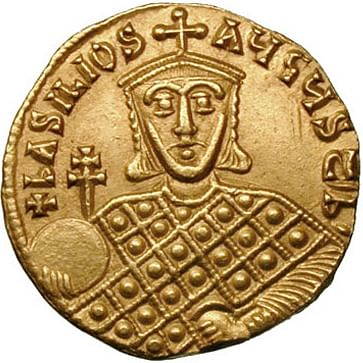
Basil I was emperor of the Byzantine Empire from 867 to 886 CE and he founded the "Macedonian" dynasty which lasted for over 200 years. Basil was an Armenian from a humble background who had risen to become the second most powerful man in the realm. When he outrageously killed his benefactor and emperor, Michael III, he became number one in Constantinopleand oversaw a golden period in Byzantine history. Losing his throne in the same way he had gained it, Basil was succeeded by his son Leo VI in 886 CE.
CO-EMPEROR WITH MICHAEL III
Michael III, also known as “Michael the Drunkard” by his detractors, was emperor of the Byzantine Empire from 842 to 867 CE. His reign saw many military successes, especially in the east but the young ruler, later known for his love of wine and song, made the fateful decision to befriend and promote a certain uncouth Armenian known as Basil the Macedonian. Basil had probably never set foot in Macedon and his epithet seems to have derived from him having spent time with a group of prisoners of that region when he was captured by Krum, king of the Bulgars. He was from a peasant Armenian family who had relocated to Thrace but his life would be a classic rags-to-riches story.
MICHAEL III WAS WARNED THAT BASIL WAS A “LION WHO WOULD DEVOUR THEM ALL”.
Leaving his family, Basil sought his fortune in the metropolis of Constantinople and he certainly found it. Known as a talented wrestler and horseman, Basil's skills led him to be put in charge of the imperial stables - Michael was a keen charioteer - and from there, when spotted by the emperor, he was made Guardian of the Imperial Bedroom ( parakoimomenos ). In his new role Basil removed, by any means he saw fit, the enemies of the emperor. By far the biggest name to be targeted was Bardas, uncle of Michael and the chief minister responsible for much of the empire's success. Bardas was rightly suspicious of the Armenian interloper but was reassured by a solemn promise from both Basil and Michael that they had no ill-feeling towards him, an oath said to have been signed in the blood of Jesus Christ - a relic housed in the Church of St. Sophia. Basil, being illiterate, could only mark the document with an X.
Despite the promises, Basil went right on ahead and personally murdered Bardas in 865 CE. The dead general had clearly not heeded his own warning to Michael years earlier that the Armenian was a “lion who would devour them all” (Brownworth, 165).The murder was indicative of the lengths Basil would go to feed his ambition: no one was to stand in his way.

Michael III Crowns Basil Co-emperor
Michael and Basil had a complex, ill-defined and much-debated relationship with Eudokia Ingerina, Michael's mistress - Basil actually marrying her, but this may have been a ruse on Michael's part to have his mistress close at hand in the palace. What is even more extraordinary, in 866 CE Michael made Basil co-emperor ( basileus ) in a lavish ceremony in the Church of St. Sophia, likely as thanks for removing Bardas, now officially recorded as a traitor. Michael had the following statement read out at the coronation:
It is my will that Basil, the High Chamberlain, who is loyal to me, who has delivered me from my enemy and who holds me in great affection, should be the guardian and manager of my Empire and should be proclaimed by all as basilieus. (Norwich, 150)
Sixteen months later the Armenian assassin would turn out to be just as treacherous to his sponsor, though, and he had Michael brutally murdered in his bedchamber in 867 CE, claiming the throne for himself alone under the title Basil I.
SOLE EMPEROR
In the first year of his reign Basil reinstated Ignatios as the Patriarch of Constantinople (bishop). This decision improved relations with the papacy who had protested vehemently at the appointment of Photios for that position, then a layman, by Michael III. Basil was probably motivated by the need for Papal military support in Italy where Byzantine armies were busy battling the Arabs. Certainly, there was no personal issue with Photios who Basil was happy to employ as his children's tutor.Photios, in any case, got his old job back as bishop when Ignatios died in 877 CE, this time endorsed by Pope John VIII in a show of reconciliation with the Eastern Church. Photios did much to promote the study of Classical Greek and Roman literature, and he wrote some of the earliest surviving book reviews.
Ultimately, Basil did reconquer southern Italy, thanks to help from the Franks, although a notable fail was the loss of Syracuse in Sicily in 878 CE. Early in his reign Basil had seen the loss of Malta to the Arabs but a massive investment in modernising and strengthening the Byzantine navy paid dividends. Basil could call on the gifted admiral Nicetus Ooryphas, who gave his new ruler a victory against the infamous Cretan pirates, catching them on the hop by crossing the narrow isthmus of Corinth. Successes against the crumbling Arab caliphate empire were enjoyed in Cyprus, mainland Greece, and Dalmatia. Basil's armies won victories against the Paulicians in Asia Minor, too, sacking their capital at Tephrike, and moved deeper into central Asia along the Euphrates River.
PUBLIC BUILDINGS, MONUMENTS & WALLS ACROSS THE CAPITAL WERE GIVEN A MUCH-NEEDED REVAMP AFTER YEARS OF NEGLECT & DAMAGE BY EARTHQUAKES.
Back home, Basil got on with the task of governing and, if the official records are to be believed, he was especially keen to improve the lot of the poor, promote the arts in Constantinople and generally make his capital look worthy of its status. He is credited with building the Nea Ekklesia (“New Church”) on the grounds of the royal palace in 880 CE. The church was magnificent with five gilded domes, exotic marble on the inside, silver decorations on the outside, two fine fountains and bells shipped in from Venice. Unfortunately for modern tourists, the church blew up in 1453 CE after the Turks had been using it as a gunpowder store. Even more sumptuous was Basil's new palace, the Kainourgion. It had fine mosaic flooring depicting giant eagles, wall -paintings, eight columns of green stone and eight of onychite (a type of marble), and a throne room with a ceiling made from glass mosaic and solid gold filling. There was a half-dome at one end of this room with a giant painting of Basil and adoring generals presenting the emperor with a symbol from each city that his armies had conquered.
Public buildings, monuments and walls across the capital were also given a much-needed revamp after years of neglect and damage by earthquakes, notably the Church of St. Sophia which was in serious danger of toppling after a quake in 869 CE.Sadly, none of Basil's achievements in making Constantinople one of the great city's of the world still stands today.

Basil I & Leo VI Confront Each Other
Perhaps more useful to his people than architectural embellishments was Basil's determination to completely overhaul Byzantine law. During his reign a vast number of new laws were introduced in the greatest flurry of legal activity since the reign of Justinian (r. 527-565 CE). Indeed, Justinian's code was the primary target of Basil's updated revisions which also ordered laws by subject for easier future reference. Much of the emperor's new legislation - written in Greek and not Latin, as before, and known collectively as the Basilika - was ultimately encapsulated in two handbooks, the Procheiron and Epanagogue, designed to be of use to judges and lawyers.
BASIL & LEO
Basil had two heirs: Constantine, the eldest, who was from his first marriage and Leo, who was from his marriage with Eudokia. It had become customary for emperors to crown their son and chosen heir as co-emperor, even when still a child but Basil went one better and crowned both his sons, Constantine in 869 CE and Leo in 870 CE. To Basil's great distress Constantine died prematurely of unknown causes in September 879 CE, a blow from which the emperor never fully recovered and which caused him to largely withdraw from public life.
Basil's relationship with his second-choice heir was a troubled one. Leo, forced to marry a girl of his father's choosing - the pious Theophano - had acquired himself a mistress named Zoe Zautsina whom, naturally, his father disapproved of. Basil tried, unsuccessfully, to break the relationship by banishing the girl and making his son a virtual prisoner in a wing of the royal palace. Beaten, imprisoned and threatened with blinding, it is perhaps no wonder that Leo might have borne a grudge which would one day prove fatal for his father.
DEATH & LEGACY
Basil died in 886 CE. The cause, according to official records, was a hunting accident. The tale was a tall one involving the 74-year old emperor being dragged an improbable distance through the woods by a stag and then rescued by a group led by Zoe's father. It seems much more likely that Leo arranged for his father to be helped off his throne. It was a final irony and a sweet revenge from beyond the grave by Michael III that Basil's successor would be Leo, widely rumoured to actually have been the son of Michael. It is, perhaps, significant that one of the first acts of the new 19-year old emperor, now Leo VI (r. 886-912 CE), was to exhume Michael III's body from his nondescript grave and entomb him in a fine marble sarcophagus in the Church of the Holy Apostles.
Whatever the exact lineage, Basil's successors, the “Macedonian” emperors, made special efforts to whitewash the more unsavoury elements of the dynastic founder's reign. Basil's grandson, Constantine VII (r. 913-959 CE), was especially keen not to have any tarnish spread to his own image. Consequently, he wrote the biographical Vita Basilii which became the accepted historical record of Basil's life and achievements where the one-time wrestler is presented as one of the great emperors of Byzantium.
This article was made possible with generous support from the National Association for Armenian Studies and Researchand the Knights of Vartan Fund for Armenian Studies.
Basil II › Who Was
Definition and Origins
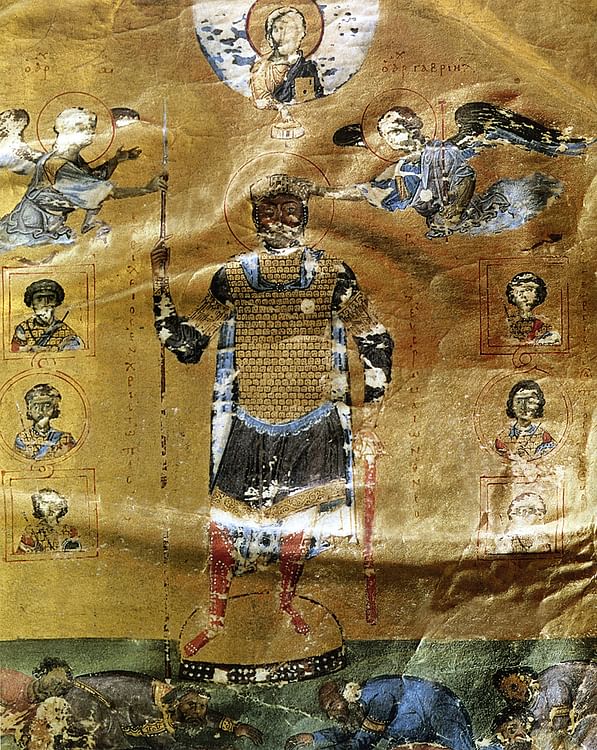
Basil II (aka Basilius II) was the emperor of the Byzantine empire from 976 to 1025 CE. He became known as the Bulgar-Slayer ( Bulgaroktonos ) for his exploits in conquering ancient Bulgaria, sweet revenge for his infamous defeat at Trajan ’s Gate. With a tight hold on Byzantine purse strings and a private army of giant Vikings, Basil got the better of at least two significant usurpers for his throne, reconquered Greece and all of the Balkans, won victories in Syria and doubled the size of the empire. This colossus of Byzantine history is the subject of a biography in the Chronographia of the 11th-century CE Byzantine historian Michael Psellos.
EARLY LIFE
Basil, born in 958 CE, was the son of Emperor Romanos II of the Macedonian dynasty, and when his father died, Basil, aged just five, and his younger brother Constantine jointly inherited the throne. The Empress Theophano, wife of Romanos, acted as their regent and married the general Nikephoros Phokas, who became Emperor Nikephoras II. It was not a happy marriage, and Theophano conspired to murder her husband in his bed in December 969 CE. The general John Tzimiskes then made himself emperor and banished Theophano to a monastery in the same year. Tzimiskes continued to act as guardian for the two young emperors and embarked on a series of successful campaigns in the Middle East. When Tzimiskes died of illness in 976 CE, Basil took his rightful place on the throne of the Byzantine empire. At least on paper, Basil shared the role with his sibling Cecil, but it was very much Basil who ruled in practice.
THERE WAS A LACK OF THE RAZZMATAZZ THAT ONE WOULD EXPECT FROM AN EMPEROR - NO LAVISH PARTIES, FINE ROBES OR FLASHY RINGS.
The young Basil was not a particularly fine physical specimen, although he was skilful at riding a horse. He shunned fine living and was not much interested in literature ; in many ways, he lived the life of an austere monk. Basil was certainly a pious man and was known to carry a statue of the Virgin in battle. These qualities, along with his dour nature, abruptness, and quick temper, combined with a complete lack of trust in anyone, unsurprisingly, did not foster much love and admiration from his subjects. There seemed to be a lack of the razzmatazz that one would expect from an emperor - no lavish parties, fine robes or flashy rings; even when he did wear the purple robes of his office, they were of a duller shade than they might have been. In warfare, too, Basil's campaigns, for all their success, were resolute rather than dashing, but his adroit skills of empire management would earn him respect from his people and fear from his enemies.
DOMESTIC POLICIES
Basil's immediate problem on gaining the throne was to quash a rebellion led by the aristocrat Bardas Skleros, a general who was keen to continue in the privileged position he had enjoyed under previous emperors. Basil prevailed, despite some initial defeats to Skleros in Asia Minor, and was greatly helped by his namesake chief administrator, the gifted eunuch Basil Lecapenus, the parakoimomenos (emperor's chamberlain). Basil II then had to foil another coup, this time involving his disloyal and corrupt chamberlain, which attempted to make Bardas Phokas, an aristocratic clan leader, emperor. Basil the eunuch was exiled in 985 CE. The emperor was now ready to concentrate all his efforts on ruling alone and magnificently, not even marriage or family were allowed to distract him.
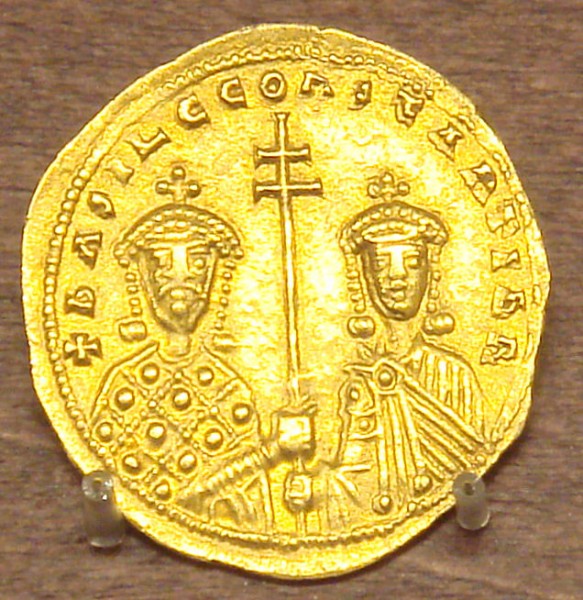
Coin of Basil II
Basil sought to further consolidate his rule by reducing the ever-increasing power of the landed aristocracy and monasteries.Both these groups were expanding their landed interests at the expense of the poorer peasantry, either by purchase or conquest. More importantly for the state, the larger landowners often avoided tax or were simply given exemptions. Basil came up with the simple idea that the large landowners, or dynatoi as they were known, pay the tax arrears of the poor. The new tax plan, known as the allelengyon, met with robust opposition, was not successful and was abandoned by Romanos III in 1028 CE.
Another strategy to further centralise power was to permit payment instead of military service in the provinces, greatly reducing the manpower of local leaders. Basil could withstand the reduction in a wider military force because of his elite troops loaned to him by allied states and, rather cleverly, he used the new tax revenue to pay a new army more loyal to his own interests.This force would come in handy in the second half of his reign.
MILITARY CAMPAIGNS
Basil's first and worst military expedition was in August 986 CE when he suffered a resounding loss to the forces of Samuel of Bulgaria (r. 976-1014 CE) in a narrow Bulgarian mountain pass known as Trajan's Gate. The emperor's army of 60,000 had already suffered an ignominious episode in their failed siege of the Bulgar capital Serdica (Sofia) but now it was wiped out, the colours lost, and Basil forced to flee back to Constantinople. The emperor would have to wait 28 years to gain his revenge, although when it came it would be total.
The consequences of the defeat at Trajan's Gate were the further expansion of Samuel's kingdom into Byzantine lands and the encouragement of two rebellions back home led by Bardas Skleros and Bardas Phokas (him again) respectively. Bardas Phokas even declared himself emperor in 987 CE. Basil, fortunately, could call on the help of Vladimir I of Kiev (r. 980-1015 CE), whose force of 6,000 Vikings bolstered his naval force and assured that the emperor restored order by 989 CE. The rebel army was routed, and three commanders were each given a uniquely tailored death: hanged, crucified, and impaled. There was a price for the assistance from Kiev, and it came in the form of Basil promising that his sister Anna would marry Vladimir, on condition that the latter agreed to be baptised. Both parties honoured their promise, useful as they were to each other as allies. The adoption of Christianity and its promotion by St Vladimir, as he would become, was a momentous action of long-lasting consequence for the Russian peoples.
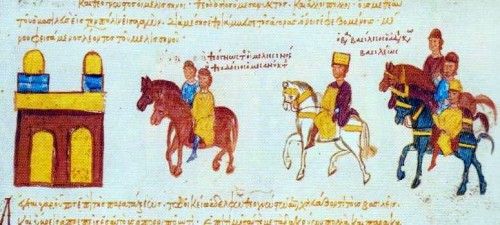
Basil II in Triumph
There were other matters to attend to besides Samuel the Bulgar. Both Antioch and Aleppo in Syria had to be protected from Arab rule and especially the increasingly ambitious Fatimids. Basil himself led a victory in northern Syria in 995 CE when his army had arrived in super-quick time out of nowhere because Basil had issued each man with two mules, one for himself and one for his baggage. The emperor then settled on a long-term policy of hurting the Arabs in their pockets by restricting all trade with the caliph.
Basil's main focus, though, was the west and revenge on the Bulgars. His approach to warfare is here described by the historian JJ Norwich:
Success for Basil depended on faultless organisation. The army must act as a single, perfectly coordinated body.When battle began, he forbade any soldier to break ranks. Heroics were punished with instant dismissal. His men complained about their master's endless inspections; but they gave him their trust because they knew that he never undertook an operation until he was certain of victory. (211)
The emperor was relentless, and after years of campaigns in both summer and winter, he won back Greece for Byzantium(997 CE), and then Pliska (1000 CE), Skopje (1004 CE) and Dyracchion (c. 1005 CE), amongst many other cities. In 1014 CE Basil finally won a great and decisive victory against the Bulgars at, appropriately enough, another mountain pass, this time at Kleidion in the Belasica Mountains. Over 15,000 of the enemy army were captured. The emperor, remembering his defeat to Samuel, carried the Byzantine tradition of mutilating the enemy to the extreme and blinded his captives, sending them back to their leader in groups of 100, each led by a one-eyed guide. Samuel was said to have died of a shock-induced stroke shortly after receiving this ominous sign of Basil's pitiless wrath.
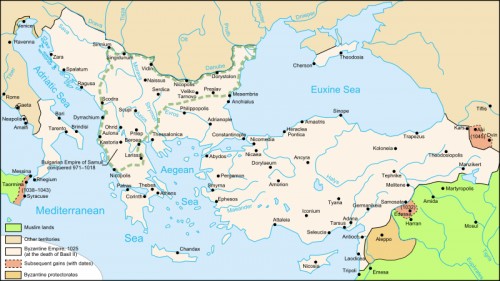
Byzantine Empire, 1025 CE
After some limited resistance led by Samuel's sons, ultimately, the Bulgar lands were incorporated into the blossoming Byzantine empire, and Basil marched victorious into Serdica in 1018 CE. The unpleasant memory of Trajan's Gate was finally erased. Basil proved more generous with his new subjects than their army. He kept taxes low - allowing payment in kind instead of the usual gold, allowed certain provinces to remain under local, princely rule, gave certain nobles high office within the empire, and permitted the Bulgarian Church to remain independent from Constantinople with the only proviso that Basil select the archbishop.
DEATH
Basil kept on campaigning to the end, with more successful adventures in Georgian Iberia and Armenia in 1021-22 CE, where he captured Vaspurkan. His territories stretched even into Mesopotamia and were consolidated by dividing the conquered regions into new provinces of the empire. Italy, too, was reorganised, and a campaign was prepared to once more face the Arabs, this time in their last stronghold in the West, Sicily. Before these plans could come to fruition, though, Basil died on the 13th or 15th of December 1025 CE. He had almost doubled the empire which now "stretched from Crete to the Crimea, and from the Straits of Messina and the River Danube to the Araxes, Euphrates, and Orontes rivers" (Mango, 80) or, to put it another way, Byzantium was now "a superpower on two continents" ( ibid, 176).
The emperor should have been buried in a splendid sarcophagus waiting for him alongside his predecessors in the Church of the Holy Apostles in Constantinople, but Basil preferred a more simple tomb in a smaller church outside the city. His final resting place carried the following inscription:
From the day that the King of Heaven called upon me to become the Emperor, the great overlord of the world, no one saw my spear lie idle. I stayed alert throughout my life and protected the children of the New Rome, valiantly campaigning both in the West and at the outposts of the East…O, man, seeing now my tomb here, reward me for my campaigns with your prayers.(Herrin, 219)
LEGACY
Basil's near-50-year reign had ensured the Byzantine empire was at its very zenith, as the historian ERA Sewter here explains in his introduction to his translation of the emperor's biography by Psellus:
Basil had devoted all his energies to the business of ruling; he had never married, spent most of his time on or near the frontiers, developed a war -machine of terrifying efficiency, coveted autocracy, but despised its outward symbols. He crushed rebellions, subdued the feudal landowners, conquered the enemies of the Empire, notably in the Danubian provinces and the East. Everywhere the might of Roman arms was respected and feared. The treasury was overflowing with the accumulated plunder of Basil's campaigns. Even the lamp of learning, despite the emperor's known indifference, was burning still, if somewhat dimly. The lot of ordinary folk in Constantinople must have been pleasant enough. For most of them life was gay and colourful, and if the city's defensive fortifications were at some points in disrepair they had no cause to dread attacks. (12)
With Basil having no children, the title of emperor resorted back to his brother Constantine, who ruled as Constantine VIII from 1025 to 1028 CE, and his daughters Zoe and Theodora. Unfortunately, Basil's successors would squander their inheritance within a generation or two. The once great empire's fortunes would wain, with none more tangible and symbolic an indicator than the ever-dwindling gold content of Byzantine coins. The 24-carat halcyon days of Basil II would, alas, never be repeated.
Dogs in Ancient Egypt › Origins
Ancient Civilizations
Ancient Egypt is well known for its association with cats but the dog was equally popular and highly regarded. Egyptologist Margaret Bunson notes that dogs "were probably domesticated in Egypt in the Pre-Dynastic eras" and they "served as hunters and as companions for the Egyptians and some mentioned their hounds in their mortuary texts" (67). An early tomb painting dated to c. 3500 BCE shows a man walking his dog on a leash in a scene recognizable to anyone in the modern day.
The dog collar and leash were most likely developed by the Sumerians earlier although evidence for both of these in Mesopotamia appears later than 3500 BCE in objects like a golden Saluki pendant from Ur dated to 3300 BCE. It is probable, however, that the Sumerians - among their many other inventions - also created the dog collar and leash since the dog was domesticated earlier in that region than in Egypt.
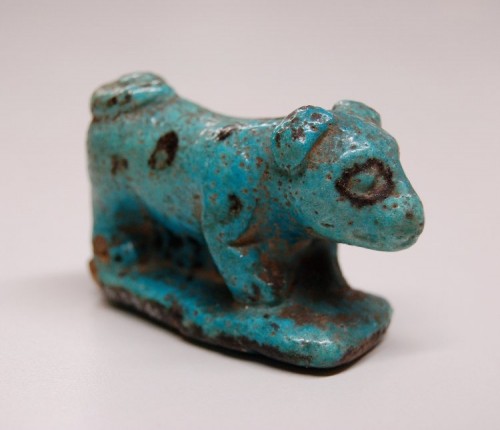
Egyptian Toy Dog
DOMESTICATION & THE DOG
Animals such as cattle, sheep, goats, pigs, asses, and different kinds of birds were domesticated in the Pre-Dynastic Period (c.6000 - c. 3150 BCE) as evidenced by grave goods and overuse of the land for grazing. By the time of the Early DynasticPeriod (c. 3150-c. 2613 BCE) cattle were the most important animal and were regarded as objects of substantial wealth as made clear through the Egyptian Cattle Count which was a form of calculating and collecting taxes.
WHETHER AS HUNTERS & COMPANIONS OR GUARDS, POLICE, OR RELIGIOUS FIGURES, THE DOG WAS A COMMON FEATURE OF THE ANCIENT EGYPTIAN LANDSCAPE.
Prior to the domestication of any of these animals, however, is that of the dog. Scholars have reached this conclusion based upon physical evidence from graves as well as inscriptions and tomb paintings. The dog, either a Basenji, Greyhound, or Saluki, is frequently depicted helping to herd cattle, wearing a wide collar fastened with a bow at the back of the neck.According to historian Jimmy Dunn, dogs "served a role in hunting, as guard and police dogs, in military actions, and as household pets" (1). The Egyptian word for dog was iwiw which referenced their bark (Dunn, 1). Whether as hunters and companions or guards, police, or religious figures, the dog was a common feature of the ancient Egyptian landscape.
EGYPTIAN DOG BREEDS
Dogs are represented in Egyptian art work from the Pre-Dynastic Period forwards either as companions, at the hunt, or in afterlife vignettes. They also appear on ceramics such as the siltstone palettes which were used in daily life (such as the Four Dogs Palette at the Louvre for cosmetics) or in ceremonies or commemorations (as with the Narmer Palette ).

Four Dogs Palette
The kinds of breeds are sometimes difficult to identify but, essentially, seem to be of seven distinct kinds. Hunting dogs were regularly referred to as tesem, a term which has attached itself to the ancestors of the Basenji, but could have been applied as easily to any dogs used in the hunt.
A tesem was not a breed of dog but designated a hunting dog. The following breeds are identified by their modern names but it should be understood that these were not the names they were known by in ancient Egypt except, perhaps, for the Basenji and Ibizan.
The Basenji : This breed is among the best attested to in ancient Egypt. It no doubt came from Nubia where it seems to have been quite common. The name is usually translated as "dog of the villagers" because it was so commonly associated with communities of people. The Basenji was used in hunting small game and as a companion, family pet, and guard dog. Basenjis could be among the dogs on the funerary stele of Intef II (2112-2063 BCE) of the 11th Dynasty and possibly his favorite dog, Beha, for whom he had an individual stele carved.

Dogs of Intef II
The Greyhound : Although the origin of the Greyhound is contested, evidence of the breed has been found in both Mesopotamia and Egypt. Graves containing Greyhounds in Mesopotamia date back to the Ubaid Period c. 5000 BCE and in Egyptian images c. 4250 BCE. The Greyhound was used in open-area hunts for large game but was also kept as a pet and a guard dog. Greyhounds are depicted throughout Egypt's history as a hunting dog but may also be the breed featured in battlescenes like the Victory Stele of Ramesses II (1279-1213 BCE) celebrating his triumph over the Hittites at the Battle of Kadesh.
The Ibizan : Probably the dog most often represented in Egyptian art. The Ibizan is of Egyptian origin but was brought from Egypt to the island of Ibiza by Phoenician traders sometime in the 7th century BCE. The breed, and its name, is usually dated from this time but there is no evidence of the dog on the island of Ibiza originally while there is a great deal suggesting its presence in Egypt. This is the dog most often referred to as the tesem and so the 'typical' Egyptian dog.
The Pharaoh : This breed is routinely claimed to have originated much later, in the 17th century CE on Malta, but its ancestors are thought to have been kept by the ancient Egyptians. Most likely it was an Egyptian breed brought to Malta by Phoenician traders. This claim is based upon art work, such as that on the tomb of Intef II toward the end of the First Intermediate Period(2181-2040 BCE). His funerary stele depicts dogs which resemble a breed similar to the later pharaoh hound more than other known Egyptian breeds. The Pharaoh is often depicted in hunting scenes and was considered the best breed for sacrifice to Anubis at Cynopolis.

Egyptian Dog Types
The Saluki : First bred in Mesopotamia by the Sumerians, the Saluki was one of the most popular breeds in the region and, later, in Egypt. Amulets and art work in Mesopotamia regularly depict this breed and it has been found in graves with and without human remains accompanying the bones. The Saluki (or Sloughi breed) was definitely present in Egypt, in spite of claims to the contrary, just not as early as in Mesopotamia. Salukis are clearly represented in tomb paintings and stelae as hunting dogs and companions.
The Whippet : Whippets were the dogs of the Egyptian kings and most likely originated through the breeding of Greyhounds with pariah dogs. The result was a smaller, faster, hunting dog. Whippets were popular for hunting in open terrain where they could make the best use of their speed in bringing down game. Although they are sometimes cited as a late breed in Egypt they seem to be the dogs represented in art from the Old Kingdom onwards.
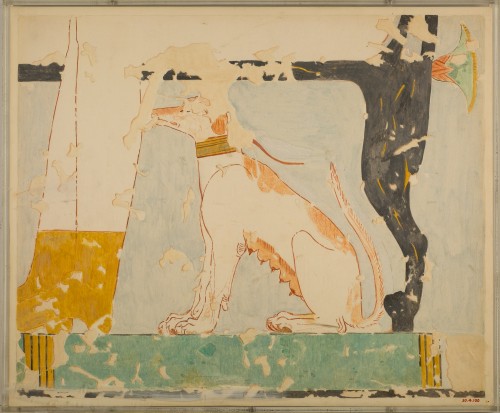
Seated Dog, Tomb of Nebamun
The Molossian : Bred in Greece in the region of Epirus, these dogs came to Egypt through trade. They take their name from the king of Epirus, Molossus, said to be the grandson of Achilles. These dogs, or some variant of them, were well-known hunters and guard dogs in Mesopotamia and were used by the Egyptians for the same purpose but also as police dogs. They may be among the dogs, like the greyhound, depicted on the Kadesh Victory Stele of Ramesses II. The Molossus would later become best known as the fighting and war dogs of ancient Rome but seem to have become quite popular in Egypt and were most likely introduced by the Hyksos in the Second Intermediate Period (c. 1782-c.1570 BCE).
IT HAS BEEN SUGGESTED THAT THE PRESENCE OF PARIAH DOGS ENCOURAGED THE EGYPTIAN PRACTICE OF BURIAL IN TOMBS TO PROTECT THE REMAINS.
There were also pariah dogs, wild dogs and strays of mixed breed, who often hunted around the outskirts of a village or necropolis. These dogs often traveled in packs and scavenged for food. It has been suggested that the presence of pariah dogs encouraged the Egyptian practice of burial in tombs to protect the remains from them. In the early Pre-Dynastic Period the dead were buried in simple earthen graves, often quite shallow, which allowed for the pariah dogs to easily dig down and disturb them. The mastaba tomb may have, in part, developed to prevent this.
Ancient Egyptian inscriptions mention the ketket but, like the tesem, this was not a breed of dog but a description of a kind of dog. Ket means `little' in ancient Egyptian and so a ketket was any kind of small dog. Dogs which seem to be the ancestors of the modern harrier also were kept by the Egyptians but what this breed was is unknown. They seem to have been small or medium dogs of impressive speed.

Egyptian Ivory Dog
An example of a dog who would've been called a ketket is the small statue presently in the British Museum known as Dog Swallowing A Fish (item number EA 13596) dated to the late 18th Dynasty c. 1350-1300 BCE. The statue shows a puppy "wearing a collar which shows traces of gilding, with lop ears and a long bushy tail which curls around its hind quarters" and "adopts the well-known posture of a dog at play with front legs bent and rump raised in the air" (British Museum, 237). The dog holds a small bronze object in its mouth which has been interpreted as either the tail of a fish or a large fly it is playing with.The piece is carved from tusk with the bronze attachment glued in place on the mouth and two holes in its base which most likely held the statue to a wall. The British Museum observes:
The piece is brilliantly observed and belongs to a class of small carvings made towards the end of the 18th Dynasty which portrays animals that were familiar to and beloved by the Egyptians. It can have been made for no other purpose than to delight and amuse its owner. (237)
DOGS & ANUBIS
Indeed, dogs were familiar and loved by the Egyptians. This devotion is clear from the number of times they are depicted and referenced in art and inscriptions throughout the history of the civilization and the way they were generally treated.
As already noted, dogs were depicted on palettes in the Pre-Dynastic and Early Dynastic periods. During the Old Kingdom, the dog of king Khufu (2589-2566 BCE), Akbaru, was said to have been buried in the king's tomb with him. One of the best known dogs of Egypt was given his own funeral stele in this same era. Abuwtiyuw was the dog of a servant of the king (though which Old Kingdom monarch is unclear) who was honored with a burial fit for a noble. The dog's stele reads:
The dog which was the guard of His Majesty. Abuwtiyuw was his name. His Majesty ordered that he be buried ceremonially, that he be given a coffin from the royal treasury, fine linen in great quantity, and incense. His Majesty also gave perfumed ointment and ordered that a tomb be built for him by the gangs of masons. His Majesty did this for him in order that he [the dog] might be honored before the great god, Anubis. (Hobgood-Oster, 41-42).
The Basenji is the most often cited as the inspiration for the image of Anubis, one of the principal gods of the dead who guided the soul to judgment in the afterlife (although the Greyhound, Pharoah, and Ibizan are also contenders). Anubis is often referred to as "the jackal dog" but this is not how he was known to the ancient Egyptians where he is always referenced as a dog as in his epithet "the dog who swallows millions". It should be noted, however, that the Egyptians did not distinguish between the jackal and the dog, especially so with pariah dogs.

Anubis God of Lost Souls
The town of Hardai was the cult center of Anubis and so was called Cynopolis (" City of the Dog") by the Greeks. Here dogs freely roamed through Anubis' temple and were also bred for sacrifice. Mummified dogs were brought to the temple as offerings to Anubis (the "red dog", identified with the Pharaoh breed, being preferred) but the death rate of the temple dogs was not high enough to meet the demand for mummified sacrifices. A kind of puppy mill was initiated for the sole purpose of breeding dogs for sacrifice to Anubis.
DOGS, COLLARS, & THE AFTERLIFE
Under ordinary circumstances, however, killing a dog carried severe penalties and, if the dog was collared and clearly owned by another, its murder was a capital crime. The death of a family dog elicited the same grief as for a human and the family members would shave their bodies completely, including the eyebrows. As most Egyptian men and women shaved their heads to avoid lice and maintain basic hygiene, the absence of the eyebrows was the most notable sign of grief. In some periods the opposite was observed and people would not shave at all.
Even so, just as with the mourning of the death of a human being, it was believed that one would meet one's canine friend again in the afterlife. Tomb paintings of the pharaoh Tutankhamun show him in his chariot with his hunting dogs and Rameses the Great is depicted similarly. As in the case of Khufu and his companion, dogs were often buried with their masters in order to accompany them closely in the afterlife. Some dogs seem to have been killed after the death of their master and then mummified while others died earlier and still others, as at Cynopolis and perhaps at Saqqara, were ritually sacrificed.
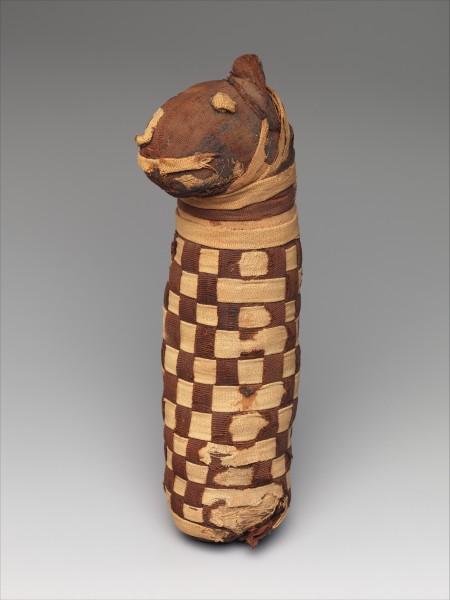
Egyptian Dog Mummy
As in many other cultures, earlier and later, the dog was seen as a kind of intermediary between worlds who could act as a guide; this is most clearly seen in the image of the dog-god Anubis. The dog who aided and guided one in life would serve the same purpose in the afterlife. The intimate relationship between dogs and their masters in Egypt is made clear through inscriptions in tombs, monuments, and temples and through Egyptian literature. Dogs, unlike cats, were always named and these names were inscribed on their collars. Dunn writes:
We even know many ancient Egyptian dog's names from leather collars as well as stelae and reliefs. They included names such as Brave One, Reliable, Good Herdsman, North-Wind, Antelope and even "Useless". Other names come from the dog's color, such as Blacky, while still other dogs were given numbers for names, such as "the Fifth". Many of the names seem to represent endearment, while others convey merely the dog's abilities or capabilities. (Dunn, 2).
These dog collars most likely began in the early periods as simple rope, probably similar to the slip-leads used today, but evolved over time into intricate works of art. Already by the Old Kingdom the collar was a thick leather ring glued together and pulled over a dog's head. During the Middle Kingdom these collars became more elaborate and were often adorned with copper and bronze studs. In the New Kingdom (c. 1570-1069 BCE) the dog collar reached its height with gold and silvercollars inscribed with the dog's name.
Two particularly interesting pieces from this period come from the tomb of Maiherpri, a noble during the reign of Thutmose IV (1400-1390 BCE), whose name translates as "Lion of the Battlefield" and so was obviously regarded as a great warrior. In addition to his quiver, wrist guards, and arrows in the tomb were two dog collars which are dyed pink and intricately adorned with images. One is ornamented with images of lotus flowers and horses punctuated by brass studs while the other depicts dogs hunting ibex and gazelle and includes the name of the dog, Tantanuit, which suggests this dog was female as "Tantanuit" was a woman's name.
Leashes, throughout Egypt's history, were either leather or papyrus rope. A dog collar excavated from a grave in modern Sudan at the site of the necropolis of Tombos, dated to the New Kingdom, is a leather band with a diamond-shaped terminus which was fitted into a slit cut in the collar; the remaining length of the leather was then used as a leash.
The devotion of people to their dogs, and the affection the dogs returned, continued in the afterlife where it was believed one found all that had seemingly been lost at death. Once the soul had been justified by Osiris and allowed to move on, one would travel to the Field of Reeds which was an idealized version of the life one had left behind on earth. All of the loved ones who had gone on before would greet the soul as it stepped into this realm and there would be the same house, the garden, the stream one had enjoyed in life and, with them, souls would again find their favorite dog faithfully awaiting their arrival home.
with permission from the Website Ancient History Encyclopedia
Content is available under License Creative Commons: Attribution-NonCommercial-ShareAlike 3.0 Unported. CC-BY-NC-SA License